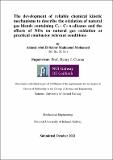| dc.contributor.advisor | Curran, Henry J. | |
| dc.contributor.author | Mohamed, Ahmed Abdelsabor Mahmoud | |
| dc.date.accessioned | 2022-03-04T09:58:25Z | |
| dc.date.available | 2022-03-04T09:58:25Z | |
| dc.date.issued | 2022-03-01 | |
| dc.identifier.uri | http://hdl.handle.net/10379/16996 | |
| dc.description.abstract | The use of natural gas (NG) for transportation and heavy-duty power generation applications has led to an increase in demand for conventional and non-conventional NG sources. Moreover, techniques such as exhaust gas recirculation (EGR) are used to control NOx emissions from combustors such as internal combustion engines (ICEs) and gas turbines (GTs). Several studies have shown that the presence of higher hydrocarbon and/or NOx species in NG mixtures can significantly affect auto-ignition behavior, which is a critical parameter for gas turbines, spark-ignited (SI), and homogeneous charge compression ignition (HCCI) engines. Thus, it is critical to understand the oxidation of NG mixtures containing different fractions of higher alkanes and the impact of NOx species on the oxidation of their mixtures in order to mitigate emissions and increase engine efficiency. Therefore, this research study focuses on building a comprehensive database of experimental measurements of ignition delay times (IDTs) for NG mixtures contain C1 – C7 n-alkanes. Moreover, the effect of the addition of NOx on both methane and ethane oxidation, the primary components of NG mixtures, is studied. These data are critical in the development of a reliable chemical kinetic mechanism to describe the oxidation of these mixtures. In addition, the chemical kinetic mechanism is used to develop empirical equations which are helpful in quickly predicting the IDTs of different mixtures. The IDT experiments were carried out in two independent but complementary experimental facilities at NUI Galway, namely the (red) rapid compression machine (RCM) used for the low- to intermediate-temperature regimes and the high-pressure shock-tube (HPST) used to study the intermediate and high temperatures regimes depending on the fuel mixture’s reactivity. The IDT measurements were performed over a wide range of operating conditions, including compressed temperatures (TC) = 650 – 2000 K, compressed pressures (pC) = 10 – 40 bar and at equivalence ratios (φ) = 0.5 – 2.0. These data provide a direct understanding of the auto-ignition characteristics of the mixtures studied and are used together with a wide range of available literature data including IDTs from RCMs and STs, speciation from a flow reactor (FR) and a jet-stirred reactor (JSR), as well as flame speed data to develop a reliable chemical kinetic mechanism. | en_IE |
| dc.publisher | NUI Galway | |
| dc.rights | Attribution-NonCommercial-NoDerivs 3.0 Ireland | |
| dc.rights | CC BY-NC-ND 3.0 IE | |
| dc.rights.uri | https://creativecommons.org/licenses/by-nc-nd/3.0/ie/ | |
| dc.rights.uri | https://creativecommons.org/licenses/by-nc-nd/3.0/ie/ | |
| dc.subject | Gas turbines | en_IE |
| dc.subject | Practical combustors | en_IE |
| dc.subject | Internal Combustion Engines | en_IE |
| dc.subject | Chemical Kinetics | en_IE |
| dc.subject | Natural Gas Oxidation | en_IE |
| dc.subject | Mechanical Engineering | en_IE |
| dc.subject | Science and Engineering | en_IE |
| dc.title | The development of reliable chemical kinetic mechanisms to describe the oxidation of natural gas blends containing C1– C7 n-alkanes and the effects of NOx on natural gas oxidation at practical combustor relevant conditions | en_IE |
| dc.type | Thesis | en |
| dc.contributor.funder | Science Foundation Ireland | en_IE |
| dc.local.note | My PhD research focused on building a comprehensive database of experimental measurements of ignition delay times (IDTs) for conventional and non-conventional Natural Gas (NG) mixtures contain C1 – C7 n-alkanes. These mixtures are identified by Siemens Energy Canada Ltd. who wants to ensure that NG mixtures of varying composition can be used in its gas turbines and determine if there is any limitation in terms of pollutants, power range, or fuel supply systems. Moreover, the effect of the addition of NOx on both methane and ethane oxidation, the primary components of NG mixtures, is studied which is necessary to achieve the highest possible efficiency of EGR applications. These data are critical in the development of a reliable chemical kinetic mechanism to describe the oxidation of these mixtures. In addition, the chemical kinetic mechanism is used to develop empirical equations which are helpful in quickly predicting the IDTs of different mixtures. | en_IE |
| dc.local.final | Yes | en_IE |
| nui.item.downloads | 180 | |


